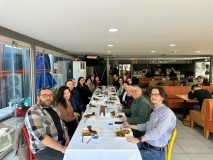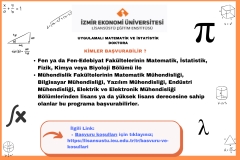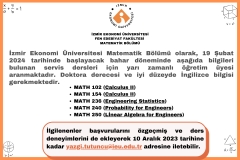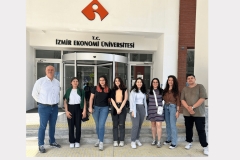
FACULTY OF ARTS AND SCIENCES
Department of Mathematics
MATH 107 | Course Introduction and Application Information
| Course Name |
Introduction to Mathematics and Statistics
|
|
Code
|
Semester
|
Theory
(hour/week) |
Application/Lab
(hour/week) |
Local Credits
|
ECTS
|
|
MATH 107
|
Fall/Spring
|
3
|
0
|
3
|
6
|
| Prerequisites |
None
|
|||||
| Course Language |
English
|
|||||
| Course Type |
Service Course
|
|||||
| Course Level |
First Cycle
|
|||||
| Mode of Delivery | Online | |||||
| Teaching Methods and Techniques of the Course | - | |||||
| Course Coordinator | ||||||
| Course Lecturer(s) | ||||||
| Assistant(s) | ||||||
| Course Objectives | This course aims to provide basic concepts of Mathematics such as functions, sets, matrices. Students will learn several mathematical and statistical concepts, methods and procedures used in social sciences, including matrices, functions, statistics, probability, estimation, hypothesis testing. The course demonstrates how mathematical and statistical methods can serve to provide tools for improving managerial decision skills. |
| Learning Outcomes |
The students who succeeded in this course;
|
| Course Description | Sets, functions, matrices, introduction to statistics, data types and collecting data, permutation, combination, probability function, random variable, their expected values and variances and distribution fuctions. |
|
|
Core Courses |
X
|
| Major Area Courses | ||
| Supportive Courses | ||
| Media and Management Skills Courses | ||
| Transferable Skill Courses |
WEEKLY SUBJECTS AND RELATED PREPARATION STUDIES
| Week | Subjects | Related Preparation |
| 1 | Critical thinking skills: Inductive reasoning; estimation; problem solving. | Allen R. Angel, C. Abbott and D. Runde, "A survey of Mathematics with Applications", 10th edition, Pearson, 2016. (Chapter 1) |
| 2 | Sets; introduction to sets, subset, proper subset; universal set; operations on sets, ven diagrams; complement of a set; De Morgan's properties; the number of elements in a set. applications od sets. Infinite sets. | Allen R. Angel, C. Abbott and D. Runde, "A survey of Mathematics with Applications", 10th edition, Pearson, 2016.(Chapter 2) |
| 3 | Logic: Statements and Logical Connectives; Truth Tables for Negation, Conjunction, and Disjunction; Truth Tables for Conditional and Biconditional; equivalent statements; symbolic arguments; Euler diagrams and Syllogistic arguments; switching circuits. | Allen R. Angel, C. Abbott and D. Runde, "A survey of Mathematics with Applications", 10th edition, Pearson, 2016.(Section 3.1, 3.2, 3.3, 3.4, 3.5, 3.6) |
| 4 | Algebra, graphs, and functions: order of operations; linear equations in one variables; linear inequalities; lines; the graph of an equation; intercepts; equation of a vertical line; slope of a line; point slope form of an equation of a line; equation of a horizontal line; slope intercept form of an equation of a line. pairs of lines; coincident lines (theorem); parallel lines; intersecting lines. | Allen R. Angel, C. Abbott and D. Runde, "A survey of Mathematics with Applications", 10th edition, Pearson, 2016. (Section 6.1, 6.2, 6.3, 6.4, 6.5). S Lipschutz, “3000 solved problems in linear algebra”, McGrow Hill.1988. ( Chapter 3 ) |
| 5 | Graphing Linear Equations; linear inequalities in two variables; solving quadratic equations by using factoring and by using the quadratic formula. | S Lipschutz, “3000 solved problems in linear algebra”, McGrow Hill.1988. (Section 6.6, 6.7, 6.8, 6.9 ) |
| 6 | Mappings and functions; mappings, the domain and image sets. | S Lipschutz, “3000 solved problems in linear algebra”, McGrow Hill.1988. ( Section 9.1 ) |
| 7 | Graphs of functions | Allen R. Angel, C. Abbott and D. Runde, "A survey of Mathematics with Applications", 10th edition, Pearson, 2016. (Section 6.10) |
| 8 | Constant functions, quadratic functions, exponential function. | Allen R. Angel, C. Abbott and D. Runde, "A survey of Mathematics with Applications", 10th edition, Pearson, 2016. (Section 6.10) |
| 9 | Introduction to probability; theoretic probability; ODDS; expected value; sample spaces, assignment of probabilities; properties of the probability of an event. | Allen R. Angel, C. Abbott and D. Runde, "A survey of Mathematics with Applications", 10th edition, Pearson, 2016. (Section 11.1, 11.2, 11.3, 11.4) |
| 10 | OR and AND problems, Independent events, conditional probability, the counting principle. | Allen R. Angel, C. Abbott and D. Runde, "A survey of Mathematics with Applications", 10th edition, Pearson, 2016. (Section 11.5, 11.6, 11.7) |
| 11 | Introduction to statistics: data and sampling; the misuses of statistics. | Allen R. Angel, C. Abbott and D. Runde, "A survey of Mathematics with Applications", 10th edition, Pearson, 2016. (Section 11.9, 12.1) |
| 12 | Frequency distributions, statistical graphs; measures of central tendency; measures of dispersion. | Allen R. Angel, C. Abbott and D. Runde, "A survey of Mathematics with Applications", 10th edition, Pearson, 2016. (Section 12.2, 12.3, 12.4) |
| 13 | The normal curve. Normal distribution. | Allen R. Angel, C. Abbott and D. Runde, "A survey of Mathematics with Applications", 10th edition, Pearson, 2016. (Section 12.5) |
| 14 | Voting and apportionment: voting methods; flaws of voting; apportionment methods; flaws of the apportionment methods. | Allen R. Angel, C. Abbott and D. Runde, "A survey of Mathematics with Applications", 10th edition, Pearson, 2016. (Section 14.1, 14.2, 14.3, 14.4) |
| 15 | Review of the semester | |
| 16 | Final exam |
| Course Notes/Textbooks | Allen R. Angel, C. Abbott and D. Runde, A survey of Mathematics with Applications, Pearson. 10th edition 2016,ISBN-13:0134112105 , “3000 solved problems in linear algebra”; S Lipschutz, McGrow Hill,1989. ISBN-13:0070380236 |
| Suggested Readings/Materials | “Calculus for Business, Economics, Life Sciences, and Social Sciences” by R.A. Barnett, M.R. Zie gler, K.E. Byleen, Prentice Hall. gler, K.E. Byleen, Prentice Hall.2014,ISBN-13:978-1292062280 |
EVALUATION SYSTEM
| Semester Activities | Number | Weigthing |
| Participation | ||
| Laboratory / Application | ||
| Field Work | ||
| Quizzes / Studio Critiques |
4
|
20
|
| Portfolio | ||
| Homework / Assignments | ||
| Presentation / Jury | ||
| Project | ||
| Seminar / Workshop | ||
| Oral Exams | ||
| Midterm |
1
|
30
|
| Final Exam |
1
|
50
|
| Total |
| Weighting of Semester Activities on the Final Grade |
5
|
50
|
| Weighting of End-of-Semester Activities on the Final Grade |
1
|
50
|
| Total |
ECTS / WORKLOAD TABLE
| Semester Activities | Number | Duration (Hours) | Workload |
|---|---|---|---|
| Theoretical Course Hours (Including exam week: 16 x total hours) |
16
|
3
|
48
|
| Laboratory / Application Hours (Including exam week: '.16.' x total hours) |
16
|
0
|
|
| Study Hours Out of Class |
14
|
3
|
42
|
| Field Work |
0
|
||
| Quizzes / Studio Critiques |
4
|
5
|
20
|
| Portfolio |
0
|
||
| Homework / Assignments |
0
|
||
| Presentation / Jury |
0
|
||
| Project |
0
|
||
| Seminar / Workshop |
0
|
||
| Oral Exam |
0
|
||
| Midterms |
1
|
30
|
30
|
| Final Exam |
1
|
40
|
40
|
| Total |
180
|
COURSE LEARNING OUTCOMES AND PROGRAM QUALIFICATIONS RELATIONSHIP
|
#
|
Program Competencies/Outcomes |
* Contribution Level
|
||||
|
1
|
2
|
3
|
4
|
5
|
||
| 1 | To be able to have a grasp of basic mathematics, applied mathematics or theories and applications of statistics. |
X | ||||
| 2 | To be able to use advanced theoretical and applied knowledge, interpret and evaluate data, define and analyze problems, develop solutions based on research and proofs by using acquired advanced knowledge and skills within the fields of mathematics or statistics. |
X | ||||
| 3 | To be able to apply mathematics or statistics in real life phenomena with interdisciplinary approach and discover their potentials. |
|||||
| 4 | To be able to evaluate the knowledge and skills acquired at an advanced level in the field with a critical approach and develop positive attitude towards lifelong learning. |
X | ||||
| 5 | To be able to share the ideas and solution proposals to problems on issues in the field with professionals, non-professionals. |
X | ||||
| 6 | To be able to take responsibility both as a team member or individual in order to solve unexpected complex problems faced within the implementations in the field, planning and managing activities towards the development of subordinates in the framework of a project. |
|||||
| 7 | To be able to use informatics and communication technologies with at least a minimum level of European Computer Driving License Advanced Level software knowledge. |
|||||
| 8 | To be able to act in accordance with social, scientific, cultural and ethical values on the stages of gathering, implementation and release of the results of data related to the field. |
|||||
| 9 | To be able to possess sufficient consciousness about the issues of universality of social rights, social justice, quality, cultural values and also environmental protection, worker's health and security. |
|||||
| 10 | To be able to connect concrete events and transfer solutions, collect data, analyze and interpret results using scientific methods and having a way of abstract thinking. |
|||||
| 11 | To be able to collect data in the areas of Mathematics or Statistics and communicate with colleagues in a foreign language. |
|||||
| 12 | To be able to speak a second foreign language at a medium level of fluency efficiently. |
|||||
| 13 | To be able to relate the knowledge accumulated throughout the human history to their field of expertise. |
|||||
*1 Lowest, 2 Low, 3 Average, 4 High, 5 Highest
NEWS |ALL NEWS
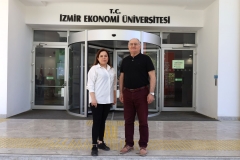
International success in mathematics
Spain-based ranking organization Scimago Institutions Ranking ranked IUE Department of Mathematics as 261st in the world and second in our country, as a
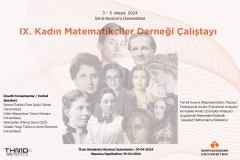
9th Workshop of Association for Turkish Women in Maths
9th Workshop of Association for Turkish Women in Maths will take place from May 03 to May 05, 2024 in Izmir, Turkey,

Our 2009 Graduate Has Been Appointed to the South Marmara Development Agency (GMKA) as the General Secretary
Onur Adıyaman, General Secretary of the Eastern Black Sea Development Agency, appointed as the General Secretary of the South Marmara Development Agency.
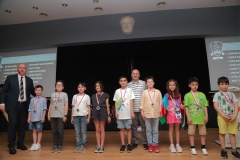
Young mathematicians came together at IUE
The award ceremony of the Turkish Mathematical Olympiad, which is organized to increase the interest of primary, secondary and high school students




